Addo
Addo and Addo-X
Anthea Agrell has kindly provided the following information about Addo:
"My grandfather, Hugo Agrell, founded Addo AB in Malmö, Sweden in 1918. My father took it to the US in 1950. As far as I know the company in the UK, in Cirencester, was a subsidiary of the Swedish company where my uncle became the MD.
What I do know with certainty is that my grandmother received the ceremonial keys to the town of Cirencester—where the factory which manufactured the machines was located—as a token of their enthusiasm that jobs were being created. I also remember the name of the British agents as being Ian Bulmer and his brother. They were located in London. I believe they did a pretty good job since as late as 1990 Addo-X's were still in use !"
In 1966 Addo was taken over by its Swedish competitor Facit, but was maintained as a separate subsidiary.
Addo are mainly known for their mechanical calculators. The full-keyboard machines have the name Addo and the 10-key machines have the name Addo-X (X from the Roman numeral for 10, maybe).
Some electronic calculators under the Addo-X range were manufactured in Britain. In 1974 "The Times" reported[1]:
"Addo,
after the merger with Facit into Facit-Addo last July, no longer manufactures calculators in Britain. The Facit-Addo range of machines is now made by the parent Facit company in Sweden, in the United States and in Japan".
Known Addo electronic calculators include:
- Addo Sabatronic
- Addo Ten/3, made in Britain.
- Addo Ten/3 MkII, made in Britain
- Addo-X 9354J, made in Japan.
- Addo-X 9364, made in Japan.
- Addo-X 9675, made in Britain.
ADDO Mod 9
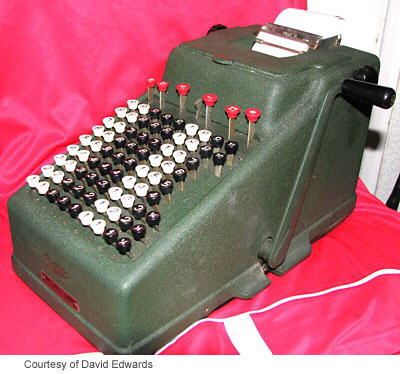
Addo Mod 9
Hand operated mechanical calculator.
Full-keyboard add-lister for the old sterling currency (£sd).
Intended for addition and subtraction with the result printed as a listing on the paper, though multiplication is posible using repeated addition.
Manufactured by Agrell.
Photographs kindly provided by David Edwards.
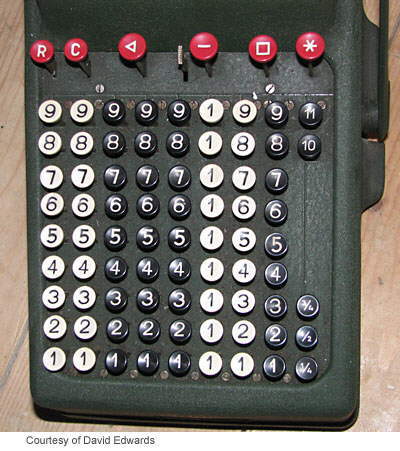
The Addo Mod 9 has 1/4, 1/2, and 3/4 keys for entering 1 farthing, 1 half-pence, and 3 farthings, respectively.
ADDO Mod 16
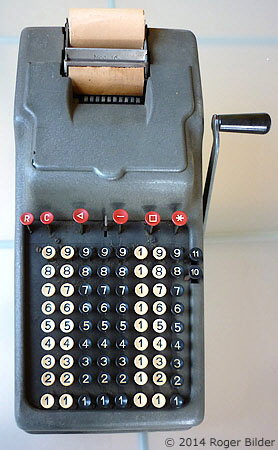
Addo Mod 16
Hand operated mechanical calculator.
Full-keyboard add-lister for the old sterling currency (£sd).
Intended for addition and subtraction with the result printed as a listing on the paper, though multiplication is posible using repeated addition.
Made in England by Agrell Manufacturing Co. Ltd.
Distributed by Bulmer's (Calculators) Ltd., 7-8 Poultry, London E.C.2.
Photograph kindly provided by Roger Bilder.
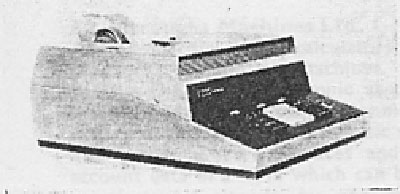
Addo Sabatronic
The magazine Office Methods & Machines of April 1967 has details of this machine being exhibited at the Business Efficiency Exhibition[2]:
"New. Sabatronic electronic printing calculator with 20-digit capacity for addition, subtraction and multiplication and 19-digit capacity for division. 4 registers are flexible for constants and/or storage and back transfer is possible between all registers and keyboard. Positioning of decimal point in print-out is automatic."
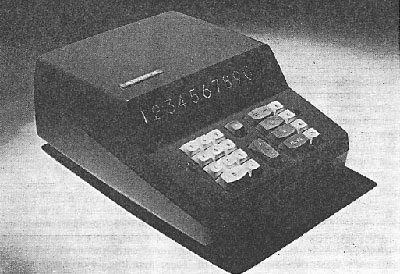
Addo Ten/3
The magazine Office Methods & Machines of December 1968 had an article about this machine[3]. It is illuminating to see
that it includes a description of how to use one of these new-fangled electronic calculators:
"Addo confidently expect their new Ten/3 electronic calculator, which uses large scale integrated circuitry to
keep the price low and reliability high, to present a major threat to Japanese domination of this market.
Instead of writing a mathematical problem on paper, the problem is pressed out on keys in the same
sequence and a series of calculations takes place in the machine. When an equals key is pressed, the answer appears on the screen. If a decimal point is involved, the machine places it in the correct position
automatically.
... The new calculator, called the Addo Ten/3, was nicknamed SAM - Simple Applied Mathematics - by Addo and the General Intrument Co. (U.K.) Ltd. who pooled their expertise to perfect it.
General Instrument's major contribution was the large-scale integrated circuitry which has helped to keep down costs and improve reliability. ...
... The calculator is highly portable measuring only 240 x 320 x 135 mm and weighing 6Kg. ... The price is £360 [GBP] [about US$900] ... ."
In April 1970 the magazine Management in Action had an advertisement[4]:
"For £320 you can posses our new model.
This is Addo's new Ten/3 Mark II. Our very calculating model - comes electrified - with even more integrated circuits. An unfailing memory that
doubles as a third register. A ten digit display. And is British all over. ..."
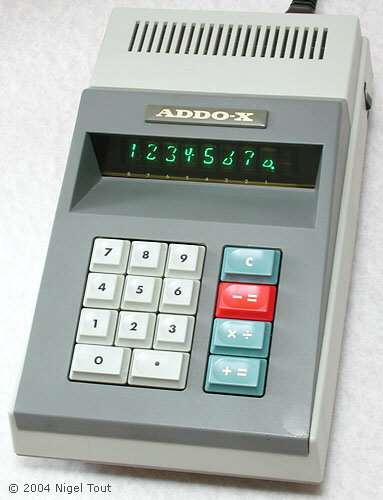
Addo-X 9354J
Power source - AC.
Display is 8-digits, stylised green Vacuum Fluorescent Display (Itron VFD) tubes, with half-height zeros.
4-functions.
Main integrated circuits made by Rockwell, in this example date-coded to mid-1970.
245 x 132 x 70 mm. (9.6" x 5.2" x 2.75").
Made in Japan.
Manufactured by Sharp, and is a version of the Sharp QT-8D.
In May 1970 this model was advertised at a price of £199 (GBP)[5] [about US$500].
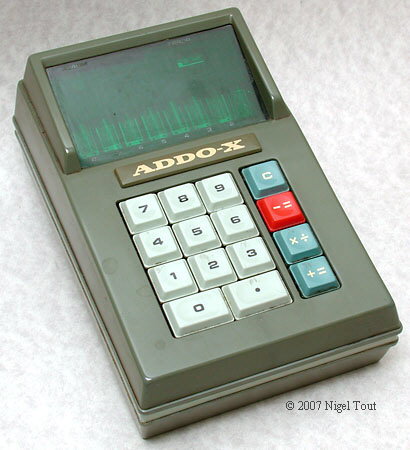
Addo-X 9364
Power source - rechargeable battery pack containing six AA cells.
Display is 8-digits, stylised green Vacuum Fluorescent Display (Itron VFD) tubes, with half-height zeros.
4-functions.
Main integrated circuits made by Rockwell, in this example date-coded to mid-1970.
245 x 132 x 70 mm. (9.6" x 5.2" x 2.75").
Made in Japan.
Made about 1970 by Sharp, and is a version of the Sharp EL-8.
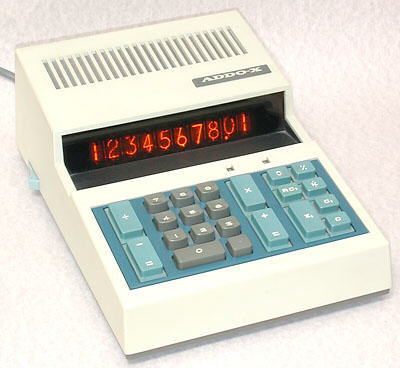
Addo-X 9675
Power source - AC.
Display is 10 digits, "Nixie"- type tubes.
4-functions, %, memory.
Main integrated circuits - Plessey 7-item chipset with MP931B, MP932B, MP933B, MP934B, MP935B, MP936B, MP937B.
275 x 197 x 97 mm (11.8" x 7.75" x 3.8").
Made in the United Kingdom.
Made about 1972.
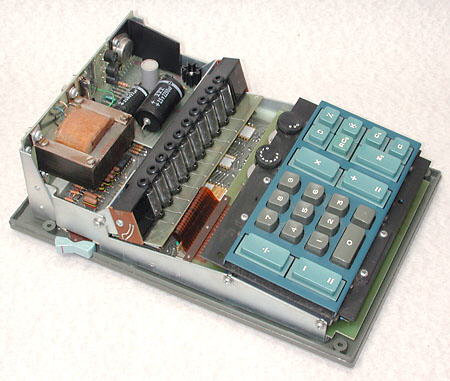
Here the cover has been removed to reveal the "Nixie"-type tubes, with display-driver board behind under the power supply, and the main calculating board right underneath.
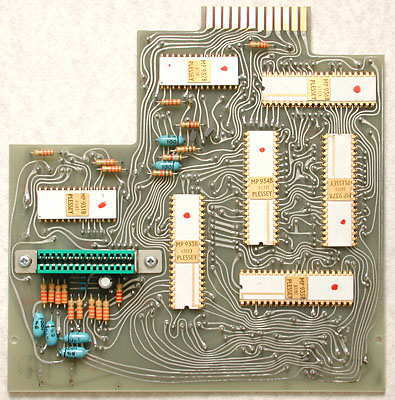
The main calculating board with the 7-piece chip-set manufactured by Plessey.
This is one of the few calculator chip-sets manufactured by Plessey. It looks to be quite costly since it requires 7 ceramic encased integrated circuits. This calculator is believed to date from about 1972, and by then both Mostek and Texas Instruments were putting the electronics of a 4-function calculator in one small plastic encapsulated integrated circuit. So a chip-set like this would then not have been competitive.
Plessey was a major company in Britain involved in radio and television-chassis production, but is especially noted for being at the forefront of developments in electronic telephone exchanges throughout the 1960s, 1970s, and 1980s. It was taken over by GEC-Siemens in 1989.
References:
British calculators
Vintage Calculators
© Text & photographs copyright Nigel Tout 2000-2019 except where noted otherwise.